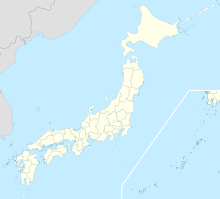Iwakuni Marine Corps Air Station
| MCAS Iwakuni | |||||||||||
|---|---|---|---|---|---|---|---|---|---|---|---|

MCAS Iwakuni logo
|
|||||||||||
 |
|||||||||||
| Summary | |||||||||||
| Airport type | Military air base | ||||||||||
| Operator | United States Marine Corps | ||||||||||
| Location | Iwakuni, Yamaguchi, Japan | ||||||||||
| Built | 1940 | ||||||||||
| In use | 1940 – present | ||||||||||
| Commander | Col Richard F. Fuerst | ||||||||||
| Occupants | |||||||||||
| Elevation AMSL | 10 ft / 3 m | ||||||||||
| Coordinates | 34°08′42″N 132°14′39″E / 34.14500°N 132.24417°ECoordinates: 34°08′42″N 132°14′39″E / 34.14500°N 132.24417°E | ||||||||||
| Website | www.mcasiwakuni.marines.mil | ||||||||||
| Map | |||||||||||
| Runways | |||||||||||
|
|||||||||||
| Helipads | |||||||||||
|
|||||||||||
| Statistics (2015) | |||||||||||
|
|||||||||||
|
Source: Japanese Ministry of Land, Infrastructure, Transport and Tourism
|
|||||||||||
Marine Aircraft Group 12
Fleet Air Wing 31
Marine Corps Air Station Iwakuni or MCAS Iwakuni (IATA: IWK, ICAO: RJOI) is a United States Marine Corps air station located in the Nishiki river delta, 1.3 NM (2.4 km; 1.5 mi) southeast of Iwakuni Station in the city of Iwakuni, Yamaguchi, Japan.
The Japanese government bought a large portion of what is today MCAS Iwakuni in 1938, with the view of establishing a naval air station. They commissioned the new base 8 July 1940. When World War II started, the Iwakuni air station was used as a training and defense base. The station housed 96 trainers and 150 Zero fighter planes on the airstrip. In September 1943, a branch of the Etajima Naval Academy was established here, with approximately 1,000 cadets undergoing training in the Basic, Junior and Senior Officer's schools at any one time. American B-29's bombed Iwakuni in May and August 1945, concentrating on the oil refinery and Rail Transport Office or train station areas. The last air raid took place just a day before the war was brought to a close.
The first allies to reach Iwakuni at the war's end were a group of U.S. Marines who had signed papers ending the conflict for the Japanese air base. After the end of World War II, various military forces from the United States, Britain, Australia, and New Zealand occupied the base and it was repaired by No. 5 Airfield Construction Squadron RAAF. It was designated a Royal Australian Air Force Base in 1948. The Americans first occupied the base in 1950 to use it as a springboard for aircraft heading to the Korean War. In 1952, the base officially became a United States military base.
...
Wikipedia

